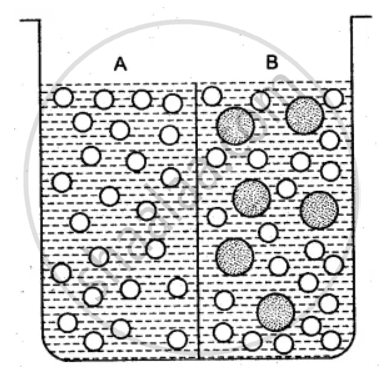Advertisements
Advertisements
प्रश्न
The apparatus arranged here signifies an important process.
(i) Name the process.
(ii) Where does this process occur in plants?
(iii) What solution is placed inside the dialysis tubing?
(iv) What happens to the level of the solution in the capillary tube?
(v) Define the process mentioned in Q. (i) above.
उत्तर
(1) The process is called osmosis.
(ii) This process occurs in the root hair cells of plants.
(iii) The solution placed inside the dialysis tubing is generally strong sugar solution or salt solution.
(iv) The level of the solution in the capillary tube rises above the original level.
(v) Osmosis is a physiological process where the water molecules or solvent molecules move through a semi-permeable membrane from a solution having a higher concentration of solvent molecules to the solution having a lower concentration of water or solvent molecules.
APPEARS IN
संबंधित प्रश्न
A plant cell placed in a certain solution got plasmolysed. What was the kind of solution?
Define the following:
Hypertonic solution
Answer the following question.
Define and or explain the term:
Plasmolysis
Choose the correct answer:
If a marine plant is transferred to fresh water, it bursts due to ___________
Mention whether the following statement is true (T) or false (F) and give explanation in support of your answer.
Plasmolysis is reverse of deplasmolysis.
The diagram below represents an experimental set up to demonstrate a vital process. Study the same and then answer the questions that follow:
(i) Name the process.
(ii) Define the above named process.
(iii) What would you observe in the experimental setup after an hour or so?
(iv) What control experiment can be set up for the above experiment?
(v) Keeping in mind the root hair cell and its surrounding name the part that corresponds to (1) Concentrated sugar solution, (2) Parchment paper, (3) Water in the beaker.
(vi) Name any other substance that can be used instead of parchment paper in the above experiment.
(vii) Mention two advantages of this process to the plant.
The beaker is divided into two chambers A and B. The big circle represents solute and the small circles solvent.
(i) What can you say about the size of the holes in the membrane, if it is to behave semi- permeably between these two?
(ii) Will the solvent molecules pass through the membrane from left to right, from right to left, in either direction or in both directions?
(iii) In which direction will there be a net movement of solvent molecules?
Give Technical Term for the following.
A solution whose concentration is equal to the cell sap.
Name the following:
The pressure through which water can rise upto some feet.
